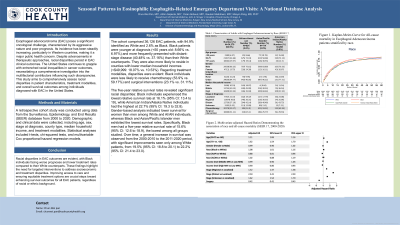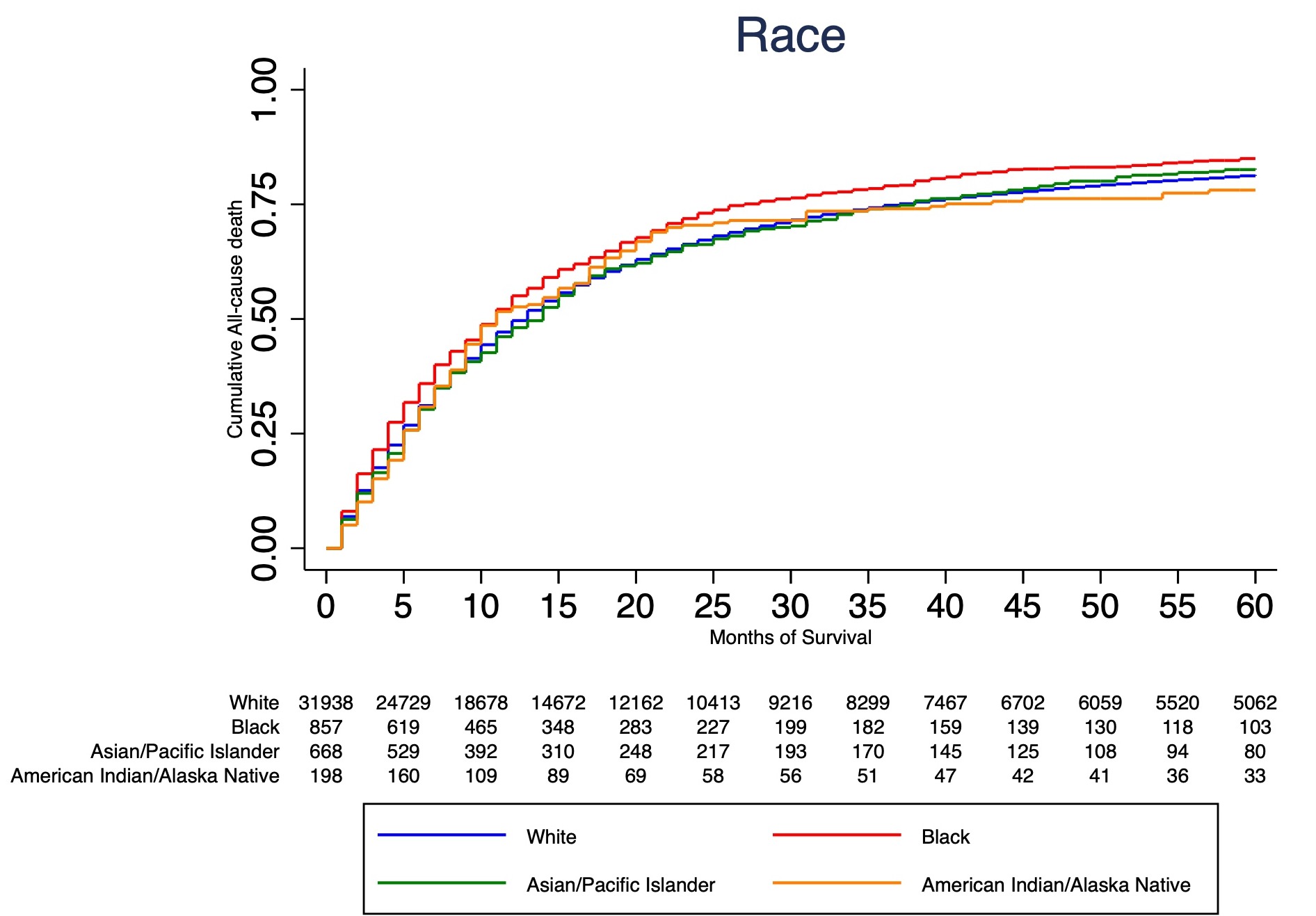Monday Poster Session
Category: Esophagus
P2235 - Unmasking the Racial Divide in Esophageal Adenocarcinoma: A SEER Database Analysis of Management and Outcomes
Monday, October 28, 2024
10:30 AM - 4:00 PM ET
Location: Exhibit Hall E

Has Audio

Chun-Wei Pan, MD
John H. Stroger, Jr. Hospital of Cook County
Chicago, IL
Presenting Author(s)
Chun-Wei Pan, MD1, Abhin Sapkota, MD1, Yazan Abboud, MD2, Gautam Maddineni, MD3, Maoyin Pang, MD, PhD4
1John H. Stroger, Jr. Hospital of Cook County, Chicago, IL; 2Rutgers New Jersey Medical School, Newark, NJ; 3Florida State University, Cape Coral, FL; 4Mayo Clinic, Jacksonville, FL
Introduction: Esophageal adenocarcinoma (EAC) is an aggressive cancer with a poor prognosis and rising incidence, posing a significant public health challenge. Despite treatment advances, racial disparities in EAC outcomes persist in the US. This study investigated factors contributing to these disparities by assessing differences in patient characteristics, treatment, and survival among EAC patients of different races.
Methods: A retrospective cohort study was conducted using data from the Surveillance, Epidemiology, and End Results (SEER) database from 2000 to 2020. Demographic and clinical data were collected, including age, sex, stage at diagnosis, county type, median household income, and treatment modalities. Statistical analyses included t-tests, chi-squared tests, and Cox proportional hazard regression models.
Results: 36,126 patients: 94.9% White, 2.6% Black. Black patients were younger at diagnosis, more distant-stage disease, and from lower income counties. Treatment disparities: Black patients less likely to receive chemotherapy (53.9% vs. 59.17%) and surgery (23.1% vs. 31.11%).
The five-year relative survival rates revealed significant racial disparities: Black individuals experienced the lowest relative survival rate at 16.1% (95% CI: 13.4 to 19), while American Indian/Alaska Native individuals had the highest at 22.7% (95% CI: 19.3 to 32.8) (Figure 1). Gender-based analysis indicated lower survival for women than men among White and AI/AN individuals, whereas Black and Asian/Pacific Islander men exhibited the lowest survival rates. Specifically, Black men had a five-year relative survival rate of 15.6% (95% CI: 12.6 to 18.9), the lowest among all groups studied. Over time, a general increase in survival was observed from the 2000-2010 to the 2011-2020 period, with significant improvements seen only among White patients, from 19.5% (95% CI: 18.8 to 20.1) to 22.2% (95% CI: 21.4 to 23.0).
Discussion: Racial disparities in EAC outcomes are evident, with Black individuals facing worse prognoses and lower treatment rates compared to their White counterparts. These findings highlight the need for targeted interventions to address socioeconomic and treatment disparities. Improving access to care and ensuring equitable treatment options are crucial steps toward enhancing survival outcomes for all EAC patients, regardless of racial or ethnic background.

Note: The table for this abstract can be viewed in the ePoster Gallery section of the ACG 2024 ePoster Site or in The American Journal of Gastroenterology's abstract supplement issue, both of which will be available starting October 27, 2024.
Disclosures:
Chun-Wei Pan, MD1, Abhin Sapkota, MD1, Yazan Abboud, MD2, Gautam Maddineni, MD3, Maoyin Pang, MD, PhD4. P2235 - Unmasking the Racial Divide in Esophageal Adenocarcinoma: A SEER Database Analysis of Management and Outcomes, ACG 2024 Annual Scientific Meeting Abstracts. Philadelphia, PA: American College of Gastroenterology.
1John H. Stroger, Jr. Hospital of Cook County, Chicago, IL; 2Rutgers New Jersey Medical School, Newark, NJ; 3Florida State University, Cape Coral, FL; 4Mayo Clinic, Jacksonville, FL
Introduction: Esophageal adenocarcinoma (EAC) is an aggressive cancer with a poor prognosis and rising incidence, posing a significant public health challenge. Despite treatment advances, racial disparities in EAC outcomes persist in the US. This study investigated factors contributing to these disparities by assessing differences in patient characteristics, treatment, and survival among EAC patients of different races.
Methods: A retrospective cohort study was conducted using data from the Surveillance, Epidemiology, and End Results (SEER) database from 2000 to 2020. Demographic and clinical data were collected, including age, sex, stage at diagnosis, county type, median household income, and treatment modalities. Statistical analyses included t-tests, chi-squared tests, and Cox proportional hazard regression models.
Results: 36,126 patients: 94.9% White, 2.6% Black. Black patients were younger at diagnosis, more distant-stage disease, and from lower income counties. Treatment disparities: Black patients less likely to receive chemotherapy (53.9% vs. 59.17%) and surgery (23.1% vs. 31.11%).
The five-year relative survival rates revealed significant racial disparities: Black individuals experienced the lowest relative survival rate at 16.1% (95% CI: 13.4 to 19), while American Indian/Alaska Native individuals had the highest at 22.7% (95% CI: 19.3 to 32.8) (Figure 1). Gender-based analysis indicated lower survival for women than men among White and AI/AN individuals, whereas Black and Asian/Pacific Islander men exhibited the lowest survival rates. Specifically, Black men had a five-year relative survival rate of 15.6% (95% CI: 12.6 to 18.9), the lowest among all groups studied. Over time, a general increase in survival was observed from the 2000-2010 to the 2011-2020 period, with significant improvements seen only among White patients, from 19.5% (95% CI: 18.8 to 20.1) to 22.2% (95% CI: 21.4 to 23.0).
Discussion: Racial disparities in EAC outcomes are evident, with Black individuals facing worse prognoses and lower treatment rates compared to their White counterparts. These findings highlight the need for targeted interventions to address socioeconomic and treatment disparities. Improving access to care and ensuring equitable treatment options are crucial steps toward enhancing survival outcomes for all EAC patients, regardless of racial or ethnic background.

Figure: Kaplan-Meier-Curve for All-cause mortality in Esophageal Adenocarcinoma patients stratified by race. Risk tables for patients at risk are given below the plot
Note: The table for this abstract can be viewed in the ePoster Gallery section of the ACG 2024 ePoster Site or in The American Journal of Gastroenterology's abstract supplement issue, both of which will be available starting October 27, 2024.
Disclosures:
Chun-Wei Pan indicated no relevant financial relationships.
Abhin Sapkota indicated no relevant financial relationships.
Yazan Abboud indicated no relevant financial relationships.
Gautam Maddineni indicated no relevant financial relationships.
Maoyin Pang indicated no relevant financial relationships.
Chun-Wei Pan, MD1, Abhin Sapkota, MD1, Yazan Abboud, MD2, Gautam Maddineni, MD3, Maoyin Pang, MD, PhD4. P2235 - Unmasking the Racial Divide in Esophageal Adenocarcinoma: A SEER Database Analysis of Management and Outcomes, ACG 2024 Annual Scientific Meeting Abstracts. Philadelphia, PA: American College of Gastroenterology.
